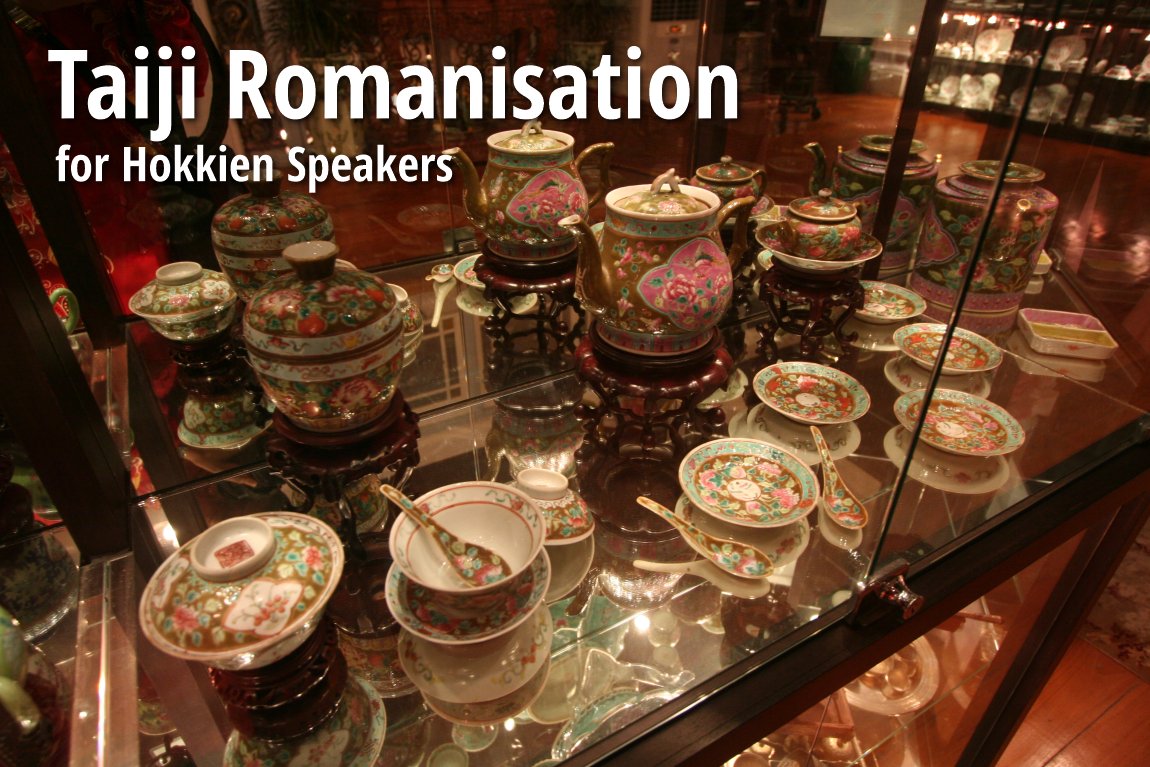
(8 October 2009)
This lesson, Taiji Romanisation for Hokkien Speakers, is intended to provide people who already speak Hokkien the means to communicate in writing, using a very easy-to-learn writing system. The writing system, Taiji Romanisation, was created in Penang for the use with Penang Hokkien. Therefore the rule of tone and tone changes (or tone sandhi) is specific to Penang Hokkien. Nevertheless, for transcribing sentences, you can use it for other dialects of Hokkien.
The Tone System of Taiji Romanisation
There are four classes of tones in Taiji, namely 1, 2, 3/33 and 4. These four tones correspond to the four tones in Mandarin.For example:
ma1
 , ma2
, ma2  , ma3
, ma3  , ma4
, ma4 
pa1
 , pa2
, pa2  , pa3
, pa3  , pa4
, pa4 
kau1
 , kau2
, kau2  , kau3
, kau3  , kau4
, kau4 
kong1
 , kong2
, kong2  , kong3
, kong3  , kong4
, kong4 
A syllable that has a meaning is called a morpheme. A morpheme can be a word on its own, for example kau1
 (to hang), jip1
(to hang), jip1  (to go in), chut3
(to go in), chut3  (to go out). Words can also be formed by putting morphemes together, for example, lau3juak1
(to go out). Words can also be formed by putting morphemes together, for example, lau3juak1  (fun), pan3gee2
(fun), pan3gee2  (cheap), etc.
(cheap), etc.When two morphemes are side by side, the one in front usually changes its tone.
Example 1: ang2
 (red) and sna1
(red) and sna1  (shirt) becomes ang3 sna1
(shirt) becomes ang3 sna1  (red shirt).
(red shirt).Example 2: wah4
 (I), boek3
(I), boek3  (want), khee3
(want), khee3  (to go), co3
(to go), co3  (to do) and kang1
(to do) and kang1  (work).
(work).Strung together, those words form the sentence:
Wah1 boek1 khee1 co1 kang1
 (I want to go to work). As you see, all the words change tones except the last one.
(I want to go to work). As you see, all the words change tones except the last one.The rule for changing tones is as follows:
Words ending in tone 1 or tone 2 change their tone to 3 when placed in front of another word.
Example: ang1
 (husband) + bor4
(husband) + bor4  (wife) = ang3bor4
(wife) = ang3bor4  (husband and wife, couple)
(husband and wife, couple)Example: ang2
 (red) + sna1
(red) + sna1  (shirt) = ang3 sna1
(shirt) = ang3 sna1  (red shirt)
(red shirt)Words ending in tone 3 or tone 4 change their tone to 1 when placed in front of another word.
Example: lau3
 (to leak) + chooi4
(to leak) + chooi4  (water) = lau1 chooi4
(water) = lau1 chooi4  (leaking water)
(leaking water)Example: kang4
 (river) + pni1
(river) + pni1  (side) = kang1 pni1
(side) = kang1 pni1  (riverside)
(riverside)Tone 33 sounds the same as tone 3, except that, words ending in tone 33 do not change the final tone when placed in front of another word.
Example: lau33
 (old) + lang2
(old) + lang2  (man) = lau33 lang2
(man) = lau33 lang2  (old man)
(old man)Note that lau3 (to leak) and lau33 (old) sound almost the same (in fact, I regard them as the same), but due to the way one changes tones while the other doesn't, we can tell which is which when we see them in writing.
The Penang Hokkien Dictionary compiles over 5,000 words in use. The dictionary has audio to help you hear how each word is pronounced. All the entries include definition in English and Malay, with a large number also showing example sentences, the Chinese characters, and the same word in Taiwanese Hokkien and Amoy Hokkien. You can reference it for free from anywhere in the world. To learn more of Penang Hokkien, go to Penang Hokkien Made Easy or try the free online course, Penang Hokkien on Memrise.
I wish you all the best in getting to know Taiji Romanisation!

Learn Penang Hokkien with Memrise
Now you can use the most user-friendly tool on the web to learn Penang Hokkien. It helps you to listen, understand and memorise. Go to Memrise, and learn Penang Hokkien at your own pace. [an error occurred while processing this directive]
[an error occurred while processing this directive]
Copyright © 2003-2025 Timothy Tye. All Rights Reserved.

 Go Back
Go Back